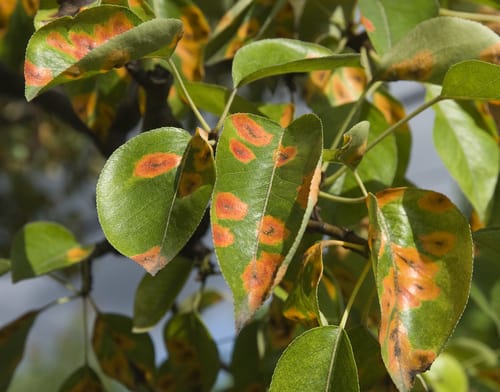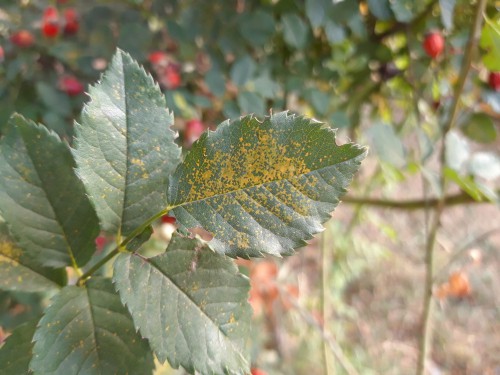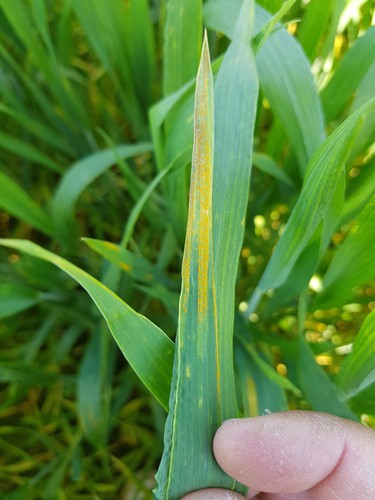Last updated on May 5th, 2022
Our site is reader supported, this means we may earn a small commission from Amazon and other affiliates when you buy through links on our site.
Rust is one of the most common fungal diseases for any garden plant. Whether you have vegetables, fruit, grasses, herbaceous plants, trees, or shrubs, they are susceptible to rust, especially roses. Rust is often very unsightly and typically reduces plant health. In the most extreme cases, they can kill your plant, but this is fairly rare.
Rust is a kind of fungal disease and the most commonly affects the leaves on your plant, however, occasionally it can affect the stems, the flowers, and even the fruit. This fungus is often yellow, red, or even grey colour depending on the species and the type of spore that is being produced. Some rust diseases have very complex life cycles with up to five different types of spores that can spread in different ways, so it’s important that it’s treated at the first signs to prevent it from getting out of control.

How to spot the symptoms of rust
Given that there are many species there are different symptoms, this is dependent on the species and the plant it is impacting. You might notice pale copper coloured leaf spots developing on your leaves, sometimes on the underside, creating somewhat raised structures and these are the spore-producing pustules.
These pustules are often found on the lower surface of the leaves and they produce huge quantities of microscopic spores that can spread very far and make their way over the entire surface of your plant if you don’t control them.

The pustules can be black, white, brown, yellow, or orange, some take on a very rusty brown colour which is what lends the disease its name. You might even notice there are dozens of these coloured pustules on a single leaf. Severely impacted leaves will eventually turn yellow and fall off.
Treating plants with rust
If you have noticed these symptoms on your plant, fast action is imperative. Given the high number of microscopic spores that can exist on a single leaf, infestation and spread happen at a rapid pace.
Each type of rust disease your plant has will have specific levels of preventative action and control. But in general, treating rust on your plants involves picking off the affected leaves first and foremost, as soon as you see them and then spraying with a fungicide to help prevent it from spreading. This is the perfect remedy for a very small infection. If you only have a few leaves that are affected, get rid of them and remove any that have already fallen off so that the spores can’t travel.
Treating plants that are heavily invested with rust
If you have a larger number of affected leaves you might not be able to pick them all off. Any diseased or dead material should be removed at the end of the growing cycle because many of the spores for rust diseases will overwinter and remain very resilient during that time, waiting until spring to strike again.
If you have rust on roses it can be worthwhile to try cutting the rose back and removing all the foliage and then spraying them with a fungicide. The problem with some other plants is that it can do more harm than good to cut the plant back hard, however, roses usually recover quickly.
How to help prevent rust in the first place
Non-chemical treatments are best done as a preventative measure. You want to avoid excess nitrogen fertiliser, remove any diseased material as soon as you see it, give your plants proper airflow, and avoid watering anywhere but the base of the plants.
Treating edible crops such as fruit and vegetables
If you have edible crops, fruits or vegetables, there are currently no fungicides that will control rust diseases safely. If you have any other ornamental plants, you can use fungicides with tebuconazole or triticonazole. If you are growing ornamentals with a lot of foliage and flowers they might be sensitive to damage by certain fungicides. This is why you should always read the labels prior to use.

Recommended fungicides for ornamentals plants and roses
Last update on 2025-12-27 / Affiliate links / Images from Amazon Product Advertising API





